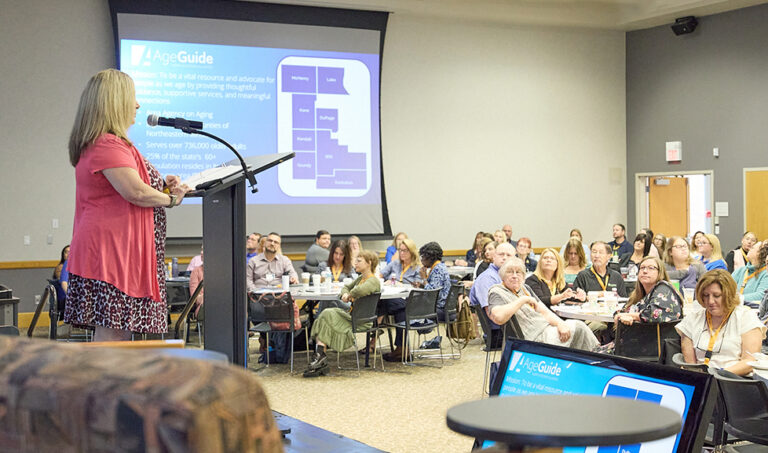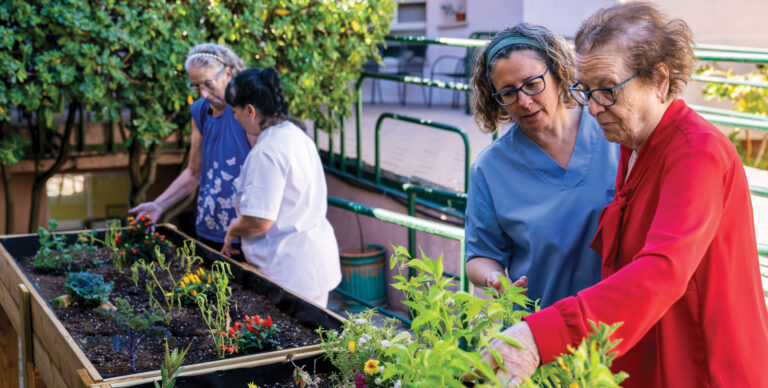Senior care experts share insights on what to do when a care recipient refuses care
Non-compliance among care recipients is a pervasive and serious challenge, whether they’re avoiding medication, skipping medical appointments, or refusing to eat. Caregivers, who are often already overstretched, may find themselves entrenched in battles as they try to persuade their loved ones to take key steps for their health.
In this issue, we asked experts on aging and caregiving to weigh in on how best to respond in these situations.
How can caregivers — both family members and professionals — best recognize early signs of distress or behavioral changes in care recipients?

Tanjeev Kaur, MD: Caregivers can spot early distress by noting sudden changes in behavior, increased confusion, withdrawal, agitation, or refusal of care. Watch for shifts in sleep, appetite, or hygiene. Nonverbal cues — like pacing, facial expressions, or vocal outbursts — often signal unmet needs. Consistent observation and empathy are key to early recognition.

Jessica Bartel: Observe the quiet moments. Changes in sleep, eating, facial expression, or cooperation often speak louder than words. Familiarity and routine help reveal the subtle shifts that indicate distress.

Matt Field: Start each day with a quick head-to-toe scan. Check the person’s expression, gait, appetite, sleep notes, and conversation spark. If anything feels off twice in 24 hours, pause, ask gentle questions, document specifics, and loop in nursing or the doctor. Patterns, not single moments, reveal brewing distress.

Kerry Peck: There is no one, clear sign that indicates someone is functioning with diminished capacity. A growing inability to understand and control financial matters, changes of character, poor hygiene, comprehension issues, disorientation, emotional changes, short-term memory loss, and changes of typical behavior are all common signs of diminished capacity.
What’s your go-to strategy for de-escalating tense or emotional moments with care recipients?

Deb Moore: This is why it’s so important to know each care recipient’s history. We all have an inner peace — that place we go to when we are stressed to help calm ourselves. Always provide a safe environment for the care recipient to feel heard and accepted. Those we care for often need assistance finding that inner peace, whether it be a song, a scent, looking at photos, or engaging with nature. Guide them to what calms them.
 Jessica Bartel: Lower your tone, lower your posture, and breathe with them. Gentle redirection helps build connection. At our care center, we’ve also onboarded a licensed psychiatrist and psychologist to support families — offering space to work through difficult moments and introducing helpful, therapeutic tools.
Jessica Bartel: Lower your tone, lower your posture, and breathe with them. Gentle redirection helps build connection. At our care center, we’ve also onboarded a licensed psychiatrist and psychologist to support families — offering space to work through difficult moments and introducing helpful, therapeutic tools.
 Terry Lallky: Stay calm, lower your voice, and soften your body language. Validate their feelings — “I see you’re upset” — before offering reassurance. Redirect with a soothing activity or familiar object. Avoid arguing or correcting; instead, focus on comfort and connection to gently shift the moment from distress to trust.
Terry Lallky: Stay calm, lower your voice, and soften your body language. Validate their feelings — “I see you’re upset” — before offering reassurance. Redirect with a soothing activity or familiar object. Avoid arguing or correcting; instead, focus on comfort and connection to gently shift the moment from distress to trust.
 Matt Field: Lower your volume, match their eye level, take synchronized breaths, and offer a simple choice like tea or water. Validate the emotion, not the behavior: “I hear you’re frustrated, and I’m staying with you.” Remove excess noise, play a favorite song, and give their hands something familiar to hold.
Matt Field: Lower your volume, match their eye level, take synchronized breaths, and offer a simple choice like tea or water. Validate the emotion, not the behavior: “I hear you’re frustrated, and I’m staying with you.” Remove excess noise, play a favorite song, and give their hands something familiar to hold.
How can we empower caregivers with tools and confidence to maintain their own emotional well-being while supporting others?
 Jessica Bartel: Normalize breaks and boundaries. Daily check-ins, peer support, and grounding tools like box breathing help reset the nervous system. Recently, I hosted a seminar on burnout and renewal that was well received by healthcare professionals. We practiced box breathing, and it truly made a difference. I also introduced the concept of AWE — absorbing moments that take your breath away — which can trigger a powerful psychological response and boost feel-good hormones.
Jessica Bartel: Normalize breaks and boundaries. Daily check-ins, peer support, and grounding tools like box breathing help reset the nervous system. Recently, I hosted a seminar on burnout and renewal that was well received by healthcare professionals. We practiced box breathing, and it truly made a difference. I also introduced the concept of AWE — absorbing moments that take your breath away — which can trigger a powerful psychological response and boost feel-good hormones.
 Kerry Peck: Educating caregivers is paramount. You don’t know what you don’t know, and the sense of being overwhelmed that comes with caring for others makes it easy to miss out on opportunities due to lack of information. We need to make sure caregivers understand the resources available to them so they can take care of themselves while also taking care of someone else. Respite care, home-based care, and adult day care are all great options.
Kerry Peck: Educating caregivers is paramount. You don’t know what you don’t know, and the sense of being overwhelmed that comes with caring for others makes it easy to miss out on opportunities due to lack of information. We need to make sure caregivers understand the resources available to them so they can take care of themselves while also taking care of someone else. Respite care, home-based care, and adult day care are all great options.
 Terry Lallky: Empower caregivers by normalizing self-care as essential, not optional. Offer access to respite, peer support, and emotional check-ins. Equip them with simple, practical tools — like mindfulness, boundaries, and reflection rituals — that fit their routines. Remind them: caring for themselves strengthens their ability to care for others with love and presence.
Terry Lallky: Empower caregivers by normalizing self-care as essential, not optional. Offer access to respite, peer support, and emotional check-ins. Equip them with simple, practical tools — like mindfulness, boundaries, and reflection rituals — that fit their routines. Remind them: caring for themselves strengthens their ability to care for others with love and presence.
 Jenny Novy: The old adage “patience is a virtue” is often easier said than done — especially in caregiving. Stay calm, speak gently, and validate emotions without judgment. Redirect attention using familiar music, comforting touch, or meaningful routine tasks. Avoid arguing or correcting; instead, meet the person where they are emotionally. When the behavior is not harmful, it’s more helpful to enter their reality than to insist on your own. Flexibility and compassion go much further than logic. With consistent reassurance, even the most difficult moments can soften over time.
Jenny Novy: The old adage “patience is a virtue” is often easier said than done — especially in caregiving. Stay calm, speak gently, and validate emotions without judgment. Redirect attention using familiar music, comforting touch, or meaningful routine tasks. Avoid arguing or correcting; instead, meet the person where they are emotionally. When the behavior is not harmful, it’s more helpful to enter their reality than to insist on your own. Flexibility and compassion go much further than logic. With consistent reassurance, even the most difficult moments can soften over time.
How can we improve communication between care teams and families to ensure continuity, trust, and consistency in complex situations?
 Kerry Peck: It truly takes a village. Frequent, concise and transparent communication in an agreed upon manner is best for all involved. Perhaps that’s creating an email group, and all updates automatically go to the members in that group. Consistency is key to avoiding a situation that can lead to anxiety and uncertainty.
Kerry Peck: It truly takes a village. Frequent, concise and transparent communication in an agreed upon manner is best for all involved. Perhaps that’s creating an email group, and all updates automatically go to the members in that group. Consistency is key to avoiding a situation that can lead to anxiety and uncertainty.
 Deb Moore: It’s important to remember that families and loved ones are often grieving the loss of the person they once knew and this, in turn, makes them fearful. Constant communication between the caregiver and family is imperative to create and maintain that trusting relationship. Communication frequently occurs when a significant event happens, but it’s important that we discuss the subtle events as well so loved ones are not surprised should a significant event occur. Caregivers also need to communicate the positive, calling a family member just to tell them that their loved one had a really good day provides so much relief and builds trust.
Deb Moore: It’s important to remember that families and loved ones are often grieving the loss of the person they once knew and this, in turn, makes them fearful. Constant communication between the caregiver and family is imperative to create and maintain that trusting relationship. Communication frequently occurs when a significant event happens, but it’s important that we discuss the subtle events as well so loved ones are not surprised should a significant event occur. Caregivers also need to communicate the positive, calling a family member just to tell them that their loved one had a really good day provides so much relief and builds trust.
 Tanjeev Kaur: Improving communication requires regular updates; shared care plans; and open, respectful dialogue. Use clear language, active listening, and digital tools for real-time coordination. Encourage family involvement in decision-making and provide consistent designated contacts. Transparent, compassionate communication builds trust, ensures continuity, and unites care teams and families in complex situations.
Tanjeev Kaur: Improving communication requires regular updates; shared care plans; and open, respectful dialogue. Use clear language, active listening, and digital tools for real-time coordination. Encourage family involvement in decision-making and provide consistent designated contacts. Transparent, compassionate communication builds trust, ensures continuity, and unites care teams and families in complex situations.
 Jenny Novy: We use a system that promotes transparency between the clients, the office, the family, and the caregivers in the home. It’s important to establish regular updates through scheduled calls, emails, or care apps. Use shared care plans and document changes clearly. Listen to family input with respect, and foster a team approach by being transparent, responsive, and consistent. Encourage in-person or virtual care conferences when possible. A collaborative mindset helps everyone feel informed, valued, and aligned in decision-making.
Jenny Novy: We use a system that promotes transparency between the clients, the office, the family, and the caregivers in the home. It’s important to establish regular updates through scheduled calls, emails, or care apps. Use shared care plans and document changes clearly. Listen to family input with respect, and foster a team approach by being transparent, responsive, and consistent. Encourage in-person or virtual care conferences when possible. A collaborative mindset helps everyone feel informed, valued, and aligned in decision-making.
What are the best ways to deal with someone who occasionally or habitually fails to take their medication?
 Jenny Novy: Start by understanding the why. Is it forgetfulness, side effects, confusion, or resistance? Is there something more going on with the person such as a urinary tract infection, small stroke, or increased dementia symptoms? Prescription routine and organization are key, and many times verbal reminders and checks are needed as well. Use pill organizers, reminder apps, or alarms to build routine. Explain medication purpose in simple terms. Involve them in decisions to encourage autonomy. For cognitive issues, try crushed or liquid forms, or disguise in food — when safe and approved.
Jenny Novy: Start by understanding the why. Is it forgetfulness, side effects, confusion, or resistance? Is there something more going on with the person such as a urinary tract infection, small stroke, or increased dementia symptoms? Prescription routine and organization are key, and many times verbal reminders and checks are needed as well. Use pill organizers, reminder apps, or alarms to build routine. Explain medication purpose in simple terms. Involve them in decisions to encourage autonomy. For cognitive issues, try crushed or liquid forms, or disguise in food — when safe and approved.
 Tanjeev Kaur: Address medication non-compliance with empathy and curiosity. Identify underlying causes: fear, confusion, side effects, or memory issues. Use reminders, pill organizers, and clear instructions. Involve the person in decisions and explain benefits. Build trust, coordinate with healthcare providers, and simplify regimens when possible to support consistent, safe medication adherence.
Tanjeev Kaur: Address medication non-compliance with empathy and curiosity. Identify underlying causes: fear, confusion, side effects, or memory issues. Use reminders, pill organizers, and clear instructions. Involve the person in decisions and explain benefits. Build trust, coordinate with healthcare providers, and simplify regimens when possible to support consistent, safe medication adherence.
 Matt Field: Start with detective work. Taste, side effects, cost, fear, or confusion often lurk behind refusal. Simplify schedules, align doses with meaningful rituals like morning coffee, use color- coded blister packs, set phone or voice assistant reminders, and celebrate streaks. When barriers shrink, adherence and dignity rise together.
Matt Field: Start with detective work. Taste, side effects, cost, fear, or confusion often lurk behind refusal. Simplify schedules, align doses with meaningful rituals like morning coffee, use color- coded blister packs, set phone or voice assistant reminders, and celebrate streaks. When barriers shrink, adherence and dignity rise together.
What are some tips for helping someone with dementia who regularly doesn’t bathe, eat, change clothes, or get enough rest?
 Jessica Bartel: Meet resistance with empathy. Offer choices, not commands. As a registered dietitian, I recommend nutrient-dense, easy-to-eat foods — soft textures, preferred flavors, and finger foods can help. Routine, comfort, and a warm tone often re-engage those resisting basic care tasks.
Jessica Bartel: Meet resistance with empathy. Offer choices, not commands. As a registered dietitian, I recommend nutrient-dense, easy-to-eat foods — soft textures, preferred flavors, and finger foods can help. Routine, comfort, and a warm tone often re-engage those resisting basic care tasks.
 Matt Field: Present care as invitations, not chores. Turn bathing into a spa moment with favorite music and warm towels, serve finger foods on colorful plates, offer two simple outfit choices set out beforehand, and create a wind-down ritual of dim lights and calm storytelling. Predictable pleasure beats endless persuasion.
Matt Field: Present care as invitations, not chores. Turn bathing into a spa moment with favorite music and warm towels, serve finger foods on colorful plates, offer two simple outfit choices set out beforehand, and create a wind-down ritual of dim lights and calm storytelling. Predictable pleasure beats endless persuasion.
 Deb Moore: Flexibility is key to helping our care recipients receive the care they need. Often, we want to follow a schedule to ensure all tasks are completed, but this may make the care recipient feel like they have no decision making in their care. Provide choices of when they eat, bathe, and take medications.
Deb Moore: Flexibility is key to helping our care recipients receive the care they need. Often, we want to follow a schedule to ensure all tasks are completed, but this may make the care recipient feel like they have no decision making in their care. Provide choices of when they eat, bathe, and take medications.
 Terry Lallky: Start with empathy, not urgency. Make routines comforting and familiar. Play favorite music, offer favorite foods, and use gentle prompts. Break tasks into small steps and celebrate participation, not perfection. Avoid power struggles; instead, create calm, inviting moments that respect their preferences and spark trust through consistency and compassion.
Terry Lallky: Start with empathy, not urgency. Make routines comforting and familiar. Play favorite music, offer favorite foods, and use gentle prompts. Break tasks into small steps and celebrate participation, not perfection. Avoid power struggles; instead, create calm, inviting moments that respect their preferences and spark trust through consistency and compassion.
In your experience, what is at the root of non-compliance for most people?
 Tanjeev Kaur: Non-compliance often stems from fear, confusion, lack of understanding, or feeling a loss of control. Emotional distress, memory issues, or mistrust can also play a role. Addressing the why with empathy, clear communication, and involving individuals in decision-making helps reduce resistance and encourages cooperation with care routines.
Tanjeev Kaur: Non-compliance often stems from fear, confusion, lack of understanding, or feeling a loss of control. Emotional distress, memory issues, or mistrust can also play a role. Addressing the why with empathy, clear communication, and involving individuals in decision-making helps reduce resistance and encourages cooperation with care routines.
 Terry Lallky: Non-compliance often stems from fear, confusion, or a need for control — especially when memory loss disrupts understanding. What looks like resistance is often self-protection. By listening with empathy, honoring their story, and adjusting our approach, we can turn “no” into a “yes” rooted in dignity and trust.
Terry Lallky: Non-compliance often stems from fear, confusion, or a need for control — especially when memory loss disrupts understanding. What looks like resistance is often self-protection. By listening with empathy, honoring their story, and adjusting our approach, we can turn “no” into a “yes” rooted in dignity and trust.
 Kerry Peck: In my experience as an elder law attorney, non-compliance most often stems from a medical issue. Perhaps an older adult is suffering from a treatable condition like a urinary tract infection, which can cause considerable confusion. But it could also be a long-term cognitive decline issue pointing towards Alzheimer’s disease or another dementia.
Kerry Peck: In my experience as an elder law attorney, non-compliance most often stems from a medical issue. Perhaps an older adult is suffering from a treatable condition like a urinary tract infection, which can cause considerable confusion. But it could also be a long-term cognitive decline issue pointing towards Alzheimer’s disease or another dementia.
 Deb Moore: I’ve found that non-compliance is often driven by the care recipient feeling a loss of control. Becoming dependent on someone to care for us can make the care recipient grieve for who they once were — bringing feelings of anger, sadness, and depression. Allowing those we care for to make choices and decisions regarding their day-to-day activities, no matter how small, can help restore the care recipient’s sense of purpose.
Deb Moore: I’ve found that non-compliance is often driven by the care recipient feeling a loss of control. Becoming dependent on someone to care for us can make the care recipient grieve for who they once were — bringing feelings of anger, sadness, and depression. Allowing those we care for to make choices and decisions regarding their day-to-day activities, no matter how small, can help restore the care recipient’s sense of purpose.
When someone you’re caring for needs a walker or wheelchair to get around, how do you respond when they willfully or without memory try to get on their feet and move without such devices?
 Terry Lallky: Gently redirect without scolding. Use calm, reassuring tones, and offer alternatives that maintain dignity, like saying, “Let’s walk together,” while guiding them to the device. Understand it may be memory, pride, or habit. Compassionate reminders, visual cues, and routine reinforcement help them feel safe while preserving independence.
Terry Lallky: Gently redirect without scolding. Use calm, reassuring tones, and offer alternatives that maintain dignity, like saying, “Let’s walk together,” while guiding them to the device. Understand it may be memory, pride, or habit. Compassionate reminders, visual cues, and routine reinforcement help them feel safe while preserving independence.
 Jenny Novy: Stay close, gently redirect, and offer alternatives like walking with supervision. Remove fall hazards and reinforce safe habits through repetition and signage. Maintain dignity while prioritizing safety.
Jenny Novy: Stay close, gently redirect, and offer alternatives like walking with supervision. Remove fall hazards and reinforce safe habits through repetition and signage. Maintain dignity while prioritizing safety.
















